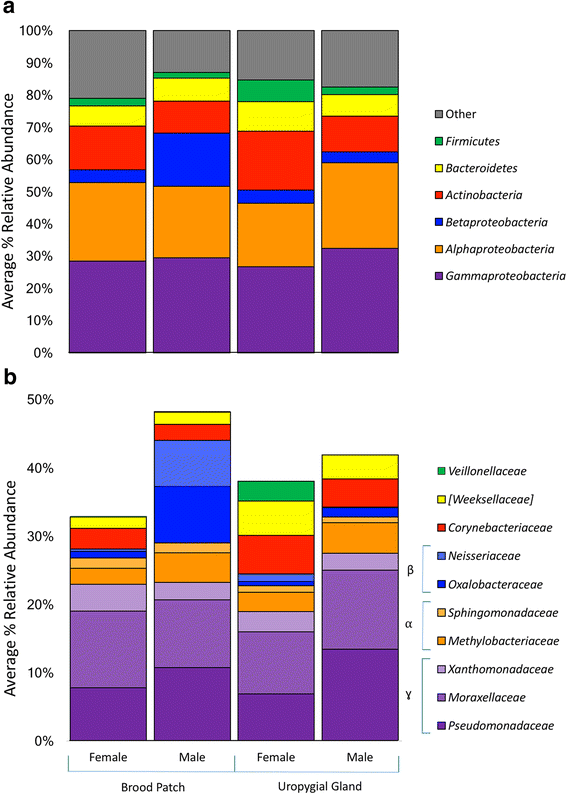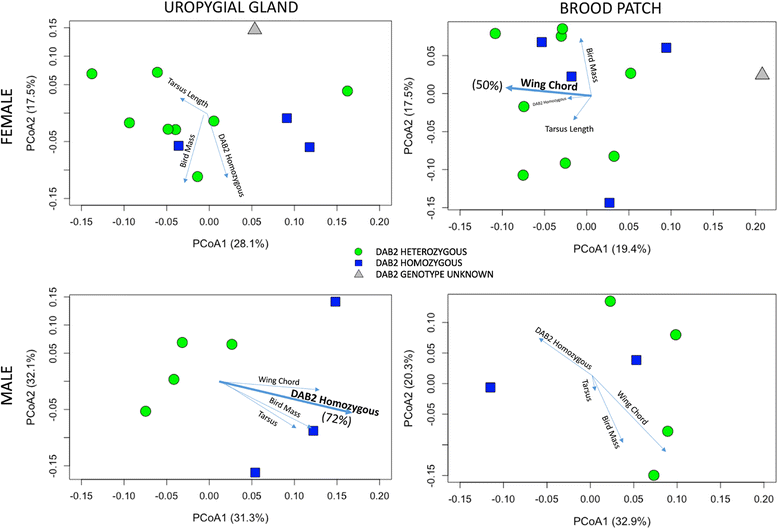Morphological and genetic factors shape the microbiome of a seabird species (Oceanodroma leucorhoa) more than environmental and social factors
- PMID: 29084611
- PMCID: PMC5663041
- DOI: 10.1186/s40168-017-0365-4
Morphological and genetic factors shape the microbiome of a seabird species (Oceanodroma leucorhoa) more than environmental and social factors
Abstract
Background: The microbiome provides multiple benefits to animal hosts that can profoundly impact health and behavior. Microbiomes are well-characterized in humans and other animals in controlled settings, yet assessments of wild bird microbial communities remain vastly understudied. This is particularly true for pelagic seabirds with unique life histories that differ from terrestrial bird species. This study was designed to examine how morphological, genetic, environmental, and social factors affect the microbiome of a burrow-nesting seabird species, Leach's storm petrel (Oceanodroma leucorhoa). These seabirds are highly olfactory and may rely on microbiome-mediated odor cues during mate selection. Composition and structure of bacterial communities associated with the uropygial gland and brood patch were assessed using 16S rRNA amplicon-based Illumina Mi-Seq analysis and compared to burrow-associated bacterial communities. This is the first study to examine microbial diversity associated with multiple body sites on a seabird species.
Results: Results indicate that sex and skin site contribute most to bacterial community variation in Leach's storm petrels and that major histocompatibility complex (MHC) genotype may impact the composition of bacterial assemblages in males. In contrast to terrestrial birds and other animals, environmental and social interactions do not significantly influence storm petrel-associated bacterial assemblages. Thus, individual morphological and genetic influences outweighed environmental and social factors on microbiome composition.
Conclusions: Contrary to observations of terrestrial birds, microbiomes of Leach's storm petrels vary most by the sex of the bird and by the body site sampled, rather than environmental surroundings or social behavior.
Keywords: Brood patch; Leach’s storm petrel; Skin microbiome; Uropygial gland.
Conflict of interest statement
Ethics approval
The research was approved by University of California Davis Animal Care and Use Protocol #17588 and Canadian Wildlife Service Permit SC2742. Bird blood samples were imported and shipped to UC Davis under USDA Veterinary Permit for Importation and Transportation of Controlled Materials and Organisms and Vectors #122202. The University of California Davis has an Animal Welfare Assurance on file with the Office of Laboratory Animal Welfare. The Assurance Number is A3433-01, protocol title: Collaborative Proposal: A New Model for Chemical Ecology: Integrating Chemistry, Genetics and Behavior to Understand the Role of Individual Scent in a Colonial Nesting Seabird.
Competing interests
The authors declare that they have no competing interests.
Publisher’s Note
Springer Nature remains neutral with regard to jurisdictional claims in published maps and institutional affiliations.
Figures


Similar articles
-
Hippocampal volume is related to complexity of nesting habitat in Leach's storm-petrel, a nocturnal procellariiform seabird.Brain Behav Evol. 1999 May-Jun;53(5-6):271-6. doi: 10.1159/000006598. Brain Behav Evol. 1999. PMID: 10473903
-
Individual Chemical Profiles in the Leach's Storm-Petrel.J Chem Ecol. 2020 Sep;46(9):845-864. doi: 10.1007/s10886-020-01207-0. Epub 2020 Aug 28. J Chem Ecol. 2020. PMID: 32856136
-
Development of the Visual System in a Burrow-Nesting Seabird: Leach's Storm Petrel.Brain Behav Evol. 2018;91(1):4-16. doi: 10.1159/000484080. Epub 2017 Dec 7. Brain Behav Evol. 2018. PMID: 29212065
-
Microbiome Sequencing Methods for Studying Human Diseases.Methods Mol Biol. 2018;1706:77-90. doi: 10.1007/978-1-4939-7471-9_5. Methods Mol Biol. 2018. PMID: 29423794 Review.
-
Current knowledge of the Southern Hemisphere marine microbiome in eukaryotic hosts and the Strait of Magellan surface microbiome project.PeerJ. 2023 Oct 3;11:e15978. doi: 10.7717/peerj.15978. eCollection 2023. PeerJ. 2023. PMID: 37810788 Free PMC article. Review.
Cited by
-
Feather chemicals contain information about the major histocompatibility complex in a highly scented seabird.Proc Biol Sci. 2022 May 25;289(1975):20220567. doi: 10.1098/rspb.2022.0567. Epub 2022 May 25. Proc Biol Sci. 2022. PMID: 35611538 Free PMC article.
-
The microbiome of African penguins (Spheniscus demersus) under managed care resembles that of wild marine mammals and birds.Sci Rep. 2023 Oct 4;13(1):16679. doi: 10.1038/s41598-023-43899-w. Sci Rep. 2023. PMID: 37794122 Free PMC article.
-
How MHCII signaling promotes benign host-microbiota interactions.PLoS Pathog. 2020 Jun 29;16(6):e1008558. doi: 10.1371/journal.ppat.1008558. eCollection 2020 Jun. PLoS Pathog. 2020. PMID: 32598378 Free PMC article. Review. No abstract available.
-
Comparative Analysis of the Gut Microbiota of Three Sympatric Terrestrial Wild Bird Species Overwintering in Farmland Habitats.Front Microbiol. 2022 Jul 19;13:905668. doi: 10.3389/fmicb.2022.905668. eCollection 2022. Front Microbiol. 2022. PMID: 35928156 Free PMC article.
-
Female-Based Patterns and Social Function in Avian Chemical Communication.J Chem Ecol. 2021 Jan;47(1):43-62. doi: 10.1007/s10886-020-01230-1. Epub 2020 Oct 26. J Chem Ecol. 2021. PMID: 33103230 Review.
References
-
- Amato KR. Co-evolution in context: The importance of studying gut microbiomes in wild animals. Microbiome Sci Med 2013;1. doi:10.2478/micsm-2013-0002.
Publication types
MeSH terms
Substances
LinkOut - more resources
Full Text Sources
Other Literature Sources
Research Materials

